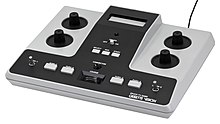 | |
| Manufacturer | Epoch |
|---|---|
| Type | Home video game console |
| Generation | Second generation |
| Release date |
|
| Introductory price | ¥13,500 ($61) |
| Discontinued | August 1984 |
| Units sold | c. 400,000[1] |
| CPU | NEC μPD777C or μPD778 |
| Removable storage | ROM cartridge |
| Display | 75 x 60; 8 colors |
| Graphics | μPD777C or μPD778 |
| Sound | Beeper |
| Input | Internal controllers |
| Predecessor | TV Vader |
| Successor | Super Cassette Vision |
The Cassette Vision[a] is a second generation home video game console made by Epoch Co. and released in Japan on July 30, 1981. A redesigned model called the Cassette Vision Jr. was released afterwards.
The term cassette is a contemporary Japanese synonym for ROM cartridge, not to be confused with the magnetic cassette tape format. In terms of power, it is comparable to the Atari 2600. The Cassette Vision has unusual controls: four knobs built into the console itself, two for each player (one for horizontal, one for vertical), plus two buttons per player.
The system originally retailed for ¥13,500, with games priced at ¥4,000. The Cassette Vision sold around 400,000 units,[2] and was the best selling video game console in Japan before Nintendo's Family Computer.[3] It received a successor called the Super Cassette Vision.
- ^ "株式会社 エポツク杜 堀江正幸氏 (pg. 9)" (in Japanese). 1998. Retrieved August 29, 2017.
- ^ "Epoch and the Cassette Vision – 1997 Developer Interview". shmuplations.com. Archived from the original on 2015-10-23. Retrieved 2020-07-25.
- ^ "CLASSIC VIDEOGAME STATION ODYSSEY/EVENT/EARLY CREATERS". Game Odyssey (in Japanese). Archived from the original on 2019-09-14. Retrieved 2024-08-13.
Cite error: There are <ref group=lower-alpha> tags or {{efn}} templates on this page, but the references will not show without a {{reflist|group=lower-alpha}} template or {{notelist}} template (see the help page).